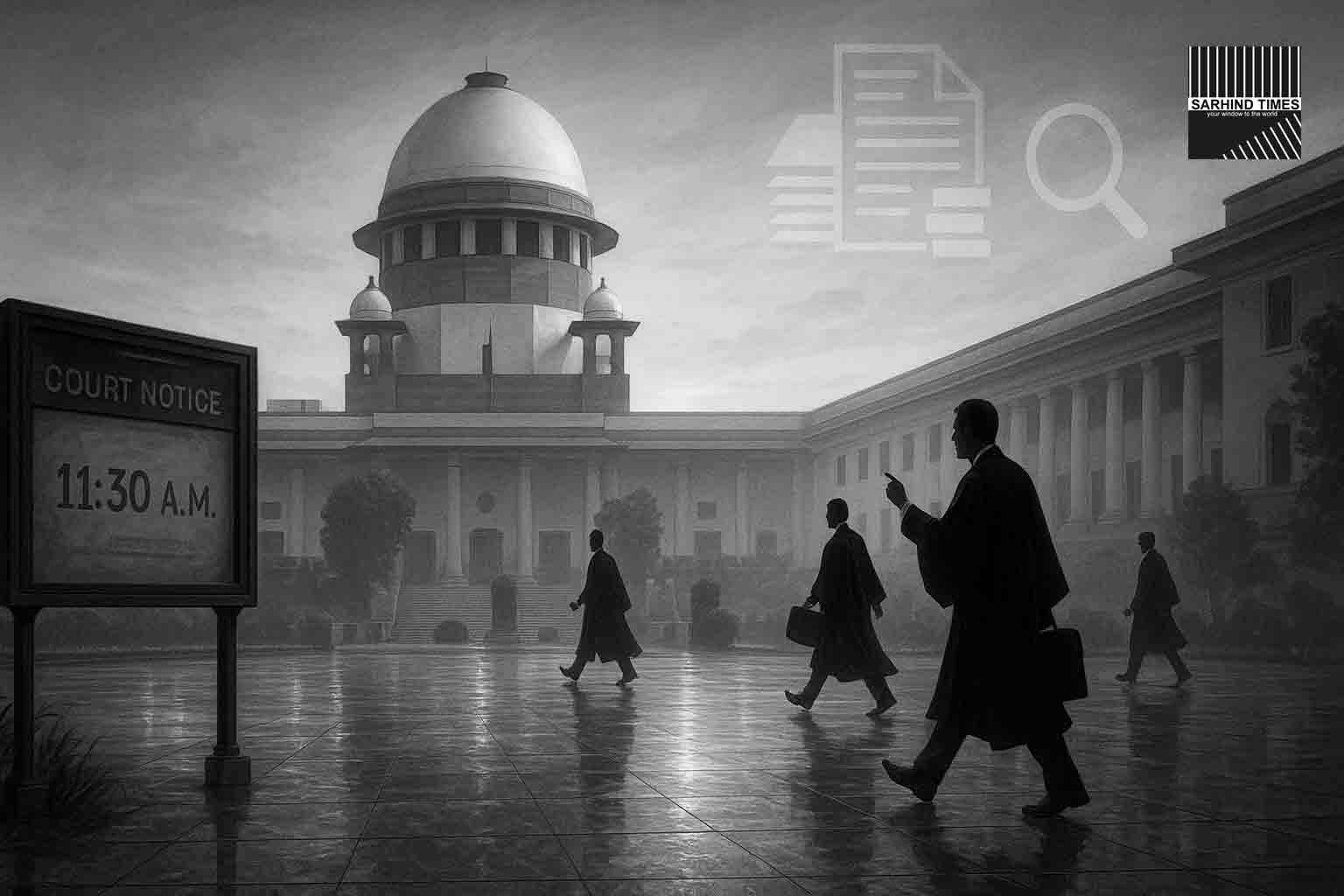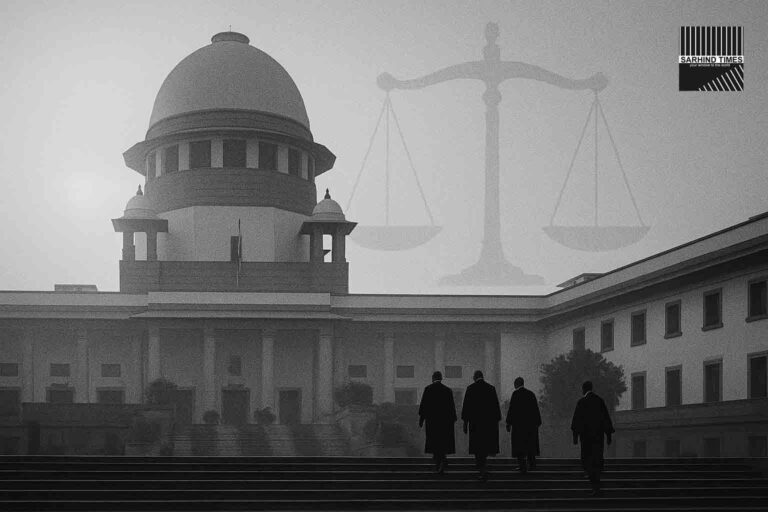Subhead: The Chief Justice’s Court convenes at 11:30 a.m. today (Monday, October 6, 2025) with updated oral-mentioning lists; the Registry flags process tweaks and a new “Verdict Finder” search portal as it leans harder into transparency and tech.
Dateline: NEW DELHI | Monday, October 6, 2025
The Supreme Court of India will sit on a special schedule this morning, with the Chief Justice’s Court commencing at 11:30 a.m., according to an administrative notice dated October 4 and circulated to the Bar and court officers. The communique, issued by the Listing branch, was posted to official channels to ensure advocates and litigants adjust their morning mentions and travel accordingly.
Today’s timing change lands alongside a run of Registry updates that have become a feature of the Court’s more public-facing listing apparatus: accessible oral-mentioning lists, cause lists pushed the same day, and iterative tweaks to the mentioning framework—each posted online as they roll out. The Court’s “All Updates” page, for instance, reflects a partial modification to the mentioning circular effective October 6, aligning the practice with current bench configurations and digital workflow.
Beyond schedules, the Court is layering in technology. Late last month it formally launched “Verdict Finder,” an Elastic-Search–based portal intended to speed up access to all Supreme Court judgments and orders—reportable and non-reportable—through a single, fast query window. The feature appears on the Court’s home page and in a dedicated circular announcing the launch.
What changes today—and why it matters
The 11:30 a.m. start for the CJI’s Court is not routine, but it’s not unusual either: staggered sittings help the Registry absorb spillovers, especially after festive weeks or periods heavy with adjournments and urgent filings. Strategically, it unclogs morning mentions, spreads footfall through the forenoon, and smooths transitions into regular boards before the CJI. The key, however, is predictability: practitioners must know early enough to recalibrate travel and client coordination. The one-page notice, issued October 4, served precisely this purpose.
Operationally, the Court has worked to publish—and archive—listing notices more consistently, including daily oral-mentioning PDFs, bench changes, and advance chamber lists for upcoming weeks. Even older notices are discoverable on the Listing Notices page, a sign that the Registry is treating such communications like a live public ledger rather than one-off bulletins.
Oral-mentioning: the Court’s pressure-release valve
For the uninitiated, an oral mention is where an advocate—typically led by an AOR or senior counsel—requests the Court to list a matter urgently, seek an early date, tag it with related cases, or address an interim liberty (such as a stay or status quo). Managing this window is delicate: too permissive, and regular boards suffer; too rigid, and urgent reliefs lag. That is why clear lists of what the Court will entertain in mentions (and when) are vital. The Court’s partial modification effective today suggests a continuing effort to standardise this tightrope.
Practically, today’s users will find the day’s cause lists—including items marked for the CJI’s Court—through the API-served PDFs updated this morning. These documents show not just final hearings and admissions but also “Mention Memo” entries, signalling that several matters have been tabled for oral mentioning before the CJI.
Inside the cause lists: what’s visible before the CJI
The daily cause list dated 06-10-2025 for the Chief Justice’s Court reflects a typical mixed board: fresh admissions, interlocutory applications, and mention memos, the latter being the formal anchor for oral-mentioning requests. While the subject categories vary, these lists are the real-time window into how the Court sequences urgent liberty issues, time-sensitive statutory deadlines, or housekeeping reliefs that avoid bottlenecks later in the week. In publishing these, the Registry preserves a traceable trail of today’s agenda.
This transparency complements routine advance chamber lists and bench-change notices that seasoned practitioners monitor when deciding whether to mention or to wait for regular listing through the automated roster. A centralized Listing Notices archive—showing day-by-day posting of oral mentions earlier in the term—makes it easier to pattern-recognise how the Court is handling surges and dips.
“Verdict Finder”: a quiet but consequential tech step
If scheduling is about when the Court speaks, “Verdict Finder” is about how fast you can find what it said. The platform, formally launched on September 26, 2025, runs on Elastic Search, enabling free-text queries across the Court’s corpus of judgments and orders, both reportable and non-reportable. For lawyers, academics, and journalists, it collapses the hunt for authoritative language, neutral-citation matches, and ratio clarification into a single window. In systems terms, it narrows the gap between pronouncement and practical discoverability.
The Court has begun to surface the tool on its front page—alongside other services such as Neutral Citation, the Certified Copy module, and the NJDG (National Judicial Data Grid) link—signalling that search is now first-class infrastructure, not a bolt-on. It is a necessary complement to the listing transparency the Registry is cultivating.
For advocates and litigants: today’s checklist
1) Verify timing. If your matter depends on an oral mention, build your morning around the 11:30 a.m. start in the CJI’s Court and plan arrival accordingly; this one-hour shift can make or break a mention in a crowded window.
2) Download the right cause list. Use the 06-10-2025 CJI cause list for the exact board, item numbers, and any mention memos. Keep a hard copy or synced PDF for quick reference in court.
3) Check the mentioning rules (today’s version). The partial modification of the mentioning circular effective today is your governing document for what can be orally pressed and what must go by application.
4) Use the Court app and portal. The official SCI mobile app and web portal have matured; use them to pull listings, orders, and now “Verdict Finder” results when crafting notes or replying to a bench query.
Why staggered mornings help
In the Court’s lived ecology, time is capacity. A staggered start can:
- Absorb backlogs from adjourned matters that need quick directions without cannibalising the rest of the day.
- Reduce queueing stress at entry points and corridors by spreading footfall.
- Protect regular boards, ensuring that urgent mentions do not swallow the pre-lunch sitting.
This is particularly effective after holiday-heavy weeks, when filings pile up and counsel return with stacks of last-minute interim prayers. Today is one such Monday. The public notice, with its three-line clarity, means fewer cold surprises at 10:30 a.m.
The transparency turn
A subtle shift is visible in how the Registry handles communications. The Listing Notices archive is no longer a graveyard of dead links; it is chronological and browsable, capturing oral-mentioning lists, bench changes, and advance chamber lists across weeks. That continuity matters: it lets the Bar predict when a class of mentions typically succeeds and how bench composition shapes the day. In short, practitioners now read the listing page the way traders read market depth—for flow, not just for the last print.
The “All Updates” page, too, mixes notices & circulars with listing notices and contact helplines, knitting back-end process with front-end service. For a public institution, this is not optics; it is throughput—and it shows up in shorter mornings and fewer crowding bottlenecks.
Friction points that remain
No listing ecosystem is perfectly smooth. Three fault lines persist:
- Over-crowded mentioning windows. Even with tighter rules, counsel will stretch categories to fit the urgent label. Strict gatekeeping by the bench and Registry is essential.
- Fragmented information flows. Advocates often toggle between PDFs, emails, and third-party trackers. Consolidation helps, but one-stop dashboards with live updates would go further.
- Bench volatility. Sudden changes—recusals, medical reasons, or unavoidable administrative shifts—can upend careful planning. The remedy is fast, unambiguous notices—which the archive model supports.
How “Verdict Finder” will change morning prep
The pre-mentioning ritual—10-minute sprints to locate that exact phrase from a controlling judgment—should get easier. With full-text search across reportable and non-reportable orders, counsel can stitch together a tight opening and pinpoint authorities for the bench. Combined with Neutral Citation and Certified Copy pipelines, it shortens the loop from search to citation to submission. The launch circular explicitly frames the tool as a faster route to orders and judgments, and its placement on the site says the same.
The view from the corridors
Members of the Bar who track listing dynamics note three welcome shifts over recent months:
- Cleaner, earlier notices for non-sittings and special benches.
- Day-of cause lists that better reflect last-minute deletions/additions.
- Consistent archiving so that patterns are visible term-over-term.
While practitioners still want more granular categorisation in oral-mentioning PDFs (for example, labelling liberty petitions separately from civil housekeeping), the direction is clear: the Court is widening the glass through which it shows how it manages capacity.
A note on expectations
It’s tempting to over-read a special morning as signalling a blockbuster docket. Experienced court-watchers caution against it. Staggered starts often mean the opposite: the Court is buying time to handle a larger mix of small but urgent reliefs, rather than teeing up one mega-matter. A look at today’s CJI cause list—a spread of admissions, IAs, and mention memos—bears this out.

























+ There are no comments
Add yours